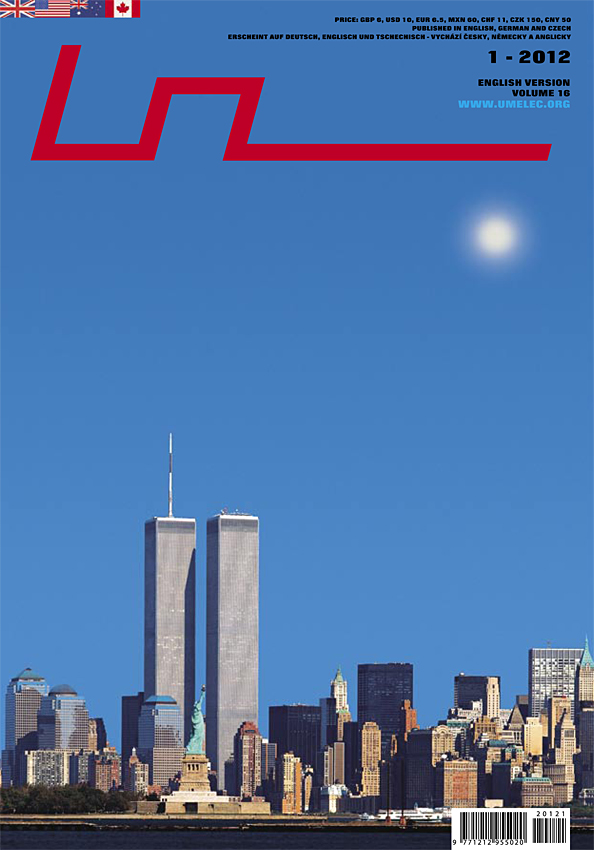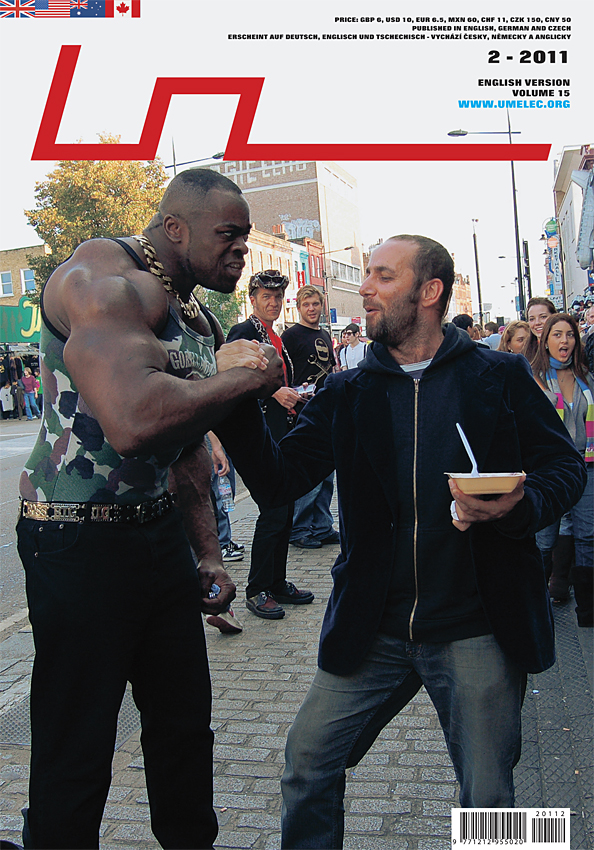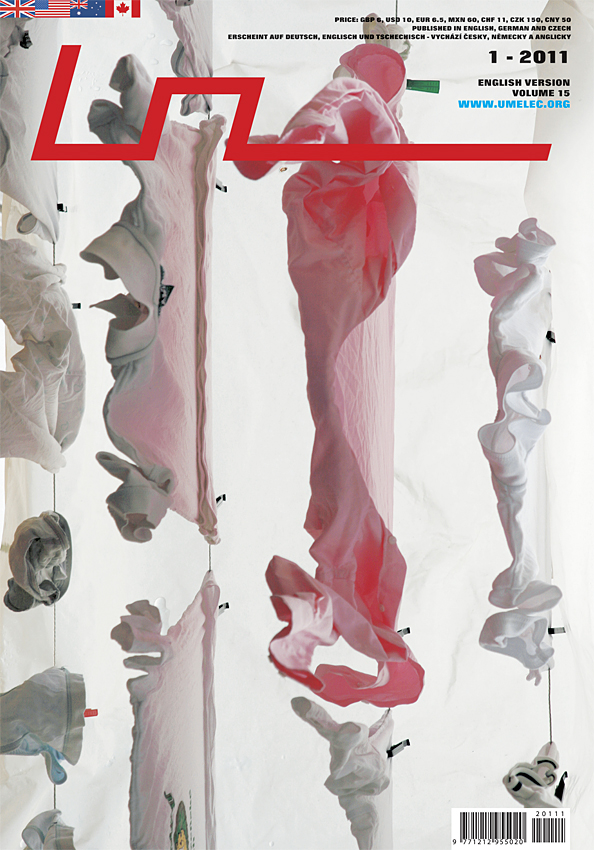Umělec (1997–) [CZ, EN, DE, ES]
Filed under magazine | Tags: · art, art criticism, art history, central europe, contemporary art, east-central europe, film, music, outsider art, politics, visual culture



“Since its inception Umelec has remained the only international art magazine in English about contemporary visual culture in Central Europe and beyond. Umelec is dedicated to more focused regional or national issues, and always tries to bring to life the current social-cultural situation, including its more marginal aspects. We do not consider culture as a decoration of the state body, but as one of the most important inspiring values of life, even if it is radical or strange.” (from the publisher)
Publisher: Divus (Ivan Mečl), Prague/London/Berlin
Editor-in-chief: Palo Fabuš; formerly: Lenka Lindaurová and Vladan Šír, Jiří Ptáček, Alena Boika
Graphic design: Dita Lamačová; formerly: Dan Vlček, Ondřej Strnad, Jakub Němeček, Ivan Mečl
Issue 1/2012 (English, HTML), also in German, Czech.
Issue 2/2011 (English, HTML), also in German, Czech.
Issue 1/2011 (English, HTML), also in German, Czech.
Other issues (HTML), incl. Special issues: “Austrian” (2009–1, EN/CZ/DE), “Mexican” (2007–2, EN/CZ/DE/ES), “German” (2005–2, EN/CZ/DE), “Swiss” (2006–2, EN/CZ), “French” (2002–1, EN/CZ). The issues from 2005–3 up to 2009–1 were also published in Spanish.
Friedrich Kittler: Optical Media: Berlin Lectures 1999 (2002–)
Filed under book | Tags: · art, art history, computer art, computing, film, film history, history of photography, image, media archeology, painting, philosophy, photography, technology

“This major new book provides a concise history of optical media from Renaissance linear perspective to late twentieth-century computer graphics. Kittler begins by looking at European painting since the Renaissance in order to discern the principles according to which modern optical perception was organized. He also discusses the development of various mechanical devices, such as the camera obscura and the laterna magica, which were closely connected to the printing press and which played a pivotal role in the media war between the Reformation and the Counter-Reformation.
After examining this history, Kittler then addresses the ways in which images were first stored and made to move, through the development of photography and film. He discusses the competitive relationship between photography and painting as well as between film and theater, as innovations like the Baroque proscenium or “picture-frame” stage evolved from elements that would later constitute cinema. The central question, however, is the impact of film on the ancient monopoly of writing, as it not only provoked new forms of competition for novelists but also fundamentally altered the status of books. In the final section, Kittler examines the development of electrical telecommunications and electronic image processing from television to computer simulations.
In short, this book provides a comprehensive introduction to the history of image production that is indispensable for anyone wishing to understand the prevailing audiovisual conditions of contemporary culture.”
Publisher Merve, Berlin, 2002
Internationaler Merve Diskurs series, 250
ISBN 3883961833, 9783883961835
331 pages
English edition
Translated by Anthony Enns
With an introduction by John Durham Peters
Publisher Polity, 2009
ISBN 0745640915, 9780745640914
vi+250 pages
Reviews: Anthony Enns (Electronic Book Review 2004), Nicholas Gane and Hannes Hansen-Magnusson (Theory Culture Society 2006), Kiss (2006, HU), Bohár (HU), Jussi Parikka (2011).
Publisher (DE)
Publisher (EN)
Worldcat (DE)
Worldcat (EN)
Optische Medien. Berliner Vorlesung 1999 (German, 2002, added on 2016-8-13, removed on 2017-8-10 upon request from publisher – read first two chapters)
Optical Media: Berlin Lectures 1999 (English, trans. Anthony Enns, 2009)
Shelley Rice (ed.): Inverted Odysseys: Claude Cahun, Maya Deren, Cindy Sherman (1999)
Filed under book | Tags: · art, art history, film, literature, self

Claude Cahun, Maya Deren, and Cindy Sherman were born in different countries, in different generations—Cahun in France in 1894, Deren in Russia in 1917, and Sherman in the United States in 1954. Yet they share a deeply theatrical obsession that shatters any notion of a unified self. All three try out identities from different social classes and geographic environments, extend their temporal range into the past and future, and transform themselves into heroes and villains, mythological creatures, and sex goddesses. The premise of Inverted Odysseys is that this expanded concept of the self—this playful urge to “try on” other roles-is more than a feminist or psychological issue. It is central to our global culture, to our definition of human identity in a world where the individual exists in a multicultural and multitemporal environment. This book is an “odyssey” through historical, theoretical, critical, and literary perspectives on the three artists viewed in the context of these issues. Contributors include Lynn Gumpert, Lucy Lippard, Jonas Mekas, Ted Mooney, Shelley Rice, and Abigail Solomon-Godeau.
Central to the book is Claude Cahun’s “Heroines” manuscript, a series of fifteen stream-of-consciousness monologues written in the voices of major women of literature and history, such as the Virgin Mary, Sappho, Cinderella, Penelope, Delilah, and Helen of Troy. Translated by Norman MacAfee, these perverse and hilarious vignettes make their English-language debut here. This is also the first time that Cahun’s text has appeared in its entirety.
The book accompanies an exhibit cocurated by Lynn Gumpert and Shelley Rice at the Grey Art Gallery, New York University.
Publisher MIT Press, in cooperation with the Grey Art Gallery, New York University, 1999
ISBN 0262681064, 9780262681063
168 pages

